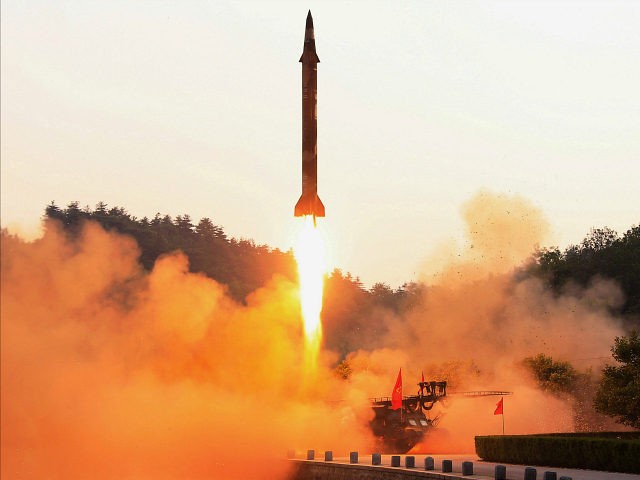SEOUL, South Korea (AFP) — North Korea proclaimed Tuesday that it had successfully tested an intercontinental ballistic missile — a watershed moment in its push to develop a nuclear weapon capable of hitting the United States.
US experts said the device could reach Alaska, and the launch, which came as the United States prepared to mark its Independence Day, triggered a Twitter outburst from US President Donald Trump who urged China to “end this nonsense once and for all.”
Its possession of a working ICBM will force a recalculation of the strategic threat it poses.
The “landmark” test of a Hwasong-14 missile was overseen by leader Kim Jong Un, an emotional female announcer said on state Korean Central Television.
It reached an altitude of 2,802 kilometers and flew 933 kilometers, she added.
The North was “a strong nuclear power state” and had “a very powerful ICBM that can strike any place in the world,” she said.
But the isolated, impoverished country has made great progress in its missile capabilities since the ascension to power of Kim, who has overseen three nuclear tests and multiple rocket launches.
In response to the launch but before the announcement, Trump asked on Twitter: “Does this guy have anything better to do with his life?”
North Korea has just launched another missile. Does this guy have anything better to do with his life? Hard to believe that South Korea…..
— Donald J. Trump (@realDonaldTrump) July 4, 2017
The United Nations has imposed multiple sets of sanctions on Pyongyang, which retorts that it needs nuclear arms to defend itself against the threat of invasion.
The “unidentified ballistic missile” was fired from a site in North Phyongan province, the South’s Joint Chiefs of Staff said in a statement, and came down in the East Sea, the Korean name for the Sea of Japan.
US Pacific Command confirmed the test and said it was a land-based, intermediate range missile that flew for 37 minutes, adding the launch did not pose a threat to North America.
It was estimated to have reached an altitude that “greatly exceeded” 2,500 kilometers, Japan said, prompting arms control specialist Jeffrey Lewis to respond on Twitter: “That’s it. It’s an ICBM. An ICBM that can hit Anchorage not San Francisco, but still.”
David Wright, of the Union of Concerned Scientists, wrote on the organization’s allthingsnuclear blog that the available figures implied the missile “could reach a maximum range of roughly 6,700 km on a standard trajectory.”
“That range would not be enough to reach the lower 48 states or the large islands of Hawaii, but would allow it to reach all of Alaska.”
The device came down in the Sea of Japan within the country’s exclusive economic zone, Tokyo’s defense ministry said in a statement, waters extending 200 nautical miles from its coast.
Prime Minister Shinzo Abe told reporters: “This launch clearly shows that the threat has grown.”
The US, Japan and South Korea will hold a summit on the sidelines of this week’s G20 meeting on the issue, he added. “Also I will encourage President Xi Jinping and President Putin to take more constructive measures.”
North Korean leader Kim Jong Un waves during a military parade in Pyongyang, North Korea, April 15, 2017 (AP Photo/Wong Maye-E, File)
South Korea’s President Moon Jae-In, who backs both engagement with the North to bring it to the negotiating table and sanctions, and met Trump for a summit in Washington at the weekend, strongly condemned what he called an “irresponsible provocation.”
Washington, South Korea’s security guarantor, has more than 28,000 troops in the country to defend it from its communist neighbor, and fears of conflict reached a peak earlier this year as the Trump administration suggested military action was an option under consideration.
There has also been anger in the United States over the death of Otto Warmbier, an American student detained in North Korea for around 18 months before he was returned home in a coma in June.
Trump has been pinning his hopes on China — North Korea’s main diplomatic ally — to bring pressure to bear on Pyongyang.
Last week he declared that Beijing’s efforts had failed, but returned to the idea on Twitter following the launch: “Perhaps China will put a heavy move on North Korea and end this nonsense once and for all!”
….and Japan will put up with this much longer. Perhaps China will put a heavy move on North Korea and end this nonsense once and for all!
— Donald J. Trump (@realDonaldTrump) July 4, 2017
But a former foreign policy adviser to Hillary Clinton warned that his comments risked undermining the credibility of both the US deterrent, and its assurances to its allies in Seoul and Tokyo.
She added: “Picking a Twitter fight with a nuclear-armed dictator is not wise — this is not reality TV anymore.”


COMMENTS
Please let us know if you're having issues with commenting.